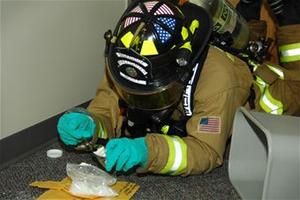BioterrorismFinding the right tools to respond to suspicious powder incidents
HazMat teams across the United States respond to hundreds of white powder calls each year in large cities where quick decision-making is critical. DHS makes it easier to buy the right technology for bio-threat incidents.

The right equipment is crucial to resolving a "white powder scenario." // Source: af.mil
First responders know that white powder scenarios — or suspected biological threats — require quick and decisive action. Having the right field-deployable equipment available to determine what the suspicious substance is can be complicated, challenging and expensive.
A PNNL release reports that recently, DHS’s Science and Technology Directorate (S&T) and Department of Energy’s Pacific Northwest National Laboratory (PNNL) issued a report that summarizes an extensive list of commercially available, hand-portable biodetection technologies. The report — Biodetection Technologies for First Responders — helps end-users such as firefighters, police officers, and HazMat workers make informed decisions about procuring the right technology for their particular need and circumstance.
“The report serves as a product buying guide for end-users as well as procurement specialists,” says Cindy Bruckner-Lea, PNNL project manager. “It provides specifics and details on dozens of commercially available technologies. This free report will be an important and useful resource for first response teams everywhere.”
The release of the report is one part of a larger effort at PNNL to create partnerships with first responders that provide value to all parties. Early on in the process, PNNL conducted dozens of interviews and surveys, and held a workshop at Seattle’s Joint Training Facility better to understand first responder biodetection and information needs, gaps, and priorities. The exchanges helped researchers have a better grasp of the context by which first responders perform their duties. This leads to better results and the ability to get the best solution faster and more efficiently.
The release notes that PNNL is also conducting biodetection assay and instrument performance tests for both anthrax and ricin bio-threats and is investigating the impact of commonly encountered “hoax” white powders. PNNL plans to facilitate performance and ergonomic testing of the most promising technology by first responders.
PNNL is also working with other agencies to help refine detection system performance requirements, standardized test plans and conditions, create guidelines for use and limitations of biodetection technology, and establish training and proficiency testing procedures.
According to law enforcement statistics, HazMat teams across the country respond to hundreds of white powder calls each year in large cities where quick decision-making is critical.
“Rapid biodetection is extremely important to the first responder community. In white powder response incidents where the health and safety of individuals may be in jeopardy, accurate and reliable results are needed promptly,” says Seattle Fire Department Assistant Chief A. D. Vickery.
The information listed in the report is primarily provided by the vendor. When possible, however, the report has been supplemented with additional information obtained from peer-reviewed publications, reports and websites that evaluate the performance of the technologies. Other findings and results will be published as the information becomes available.
PNNL has significant expertise in studying the biodetection process and in evaluating biodetection assays.
It also has established an ongoing relationship with first responders in the Pacific Northwest. In coming months, PNNL will conduct third-party testing of biodetection assay systems and instruments. Researchers will publish a report outlining performance testing in working with anthrax, ricin and commonly encountered white powders.
PNNL will attend the International Hazardous Materials Response Teams Conference on 6-9 June in Baltimore, Maryand, and will be available to discuss the report and the next phase of testing that is just getting underway.
